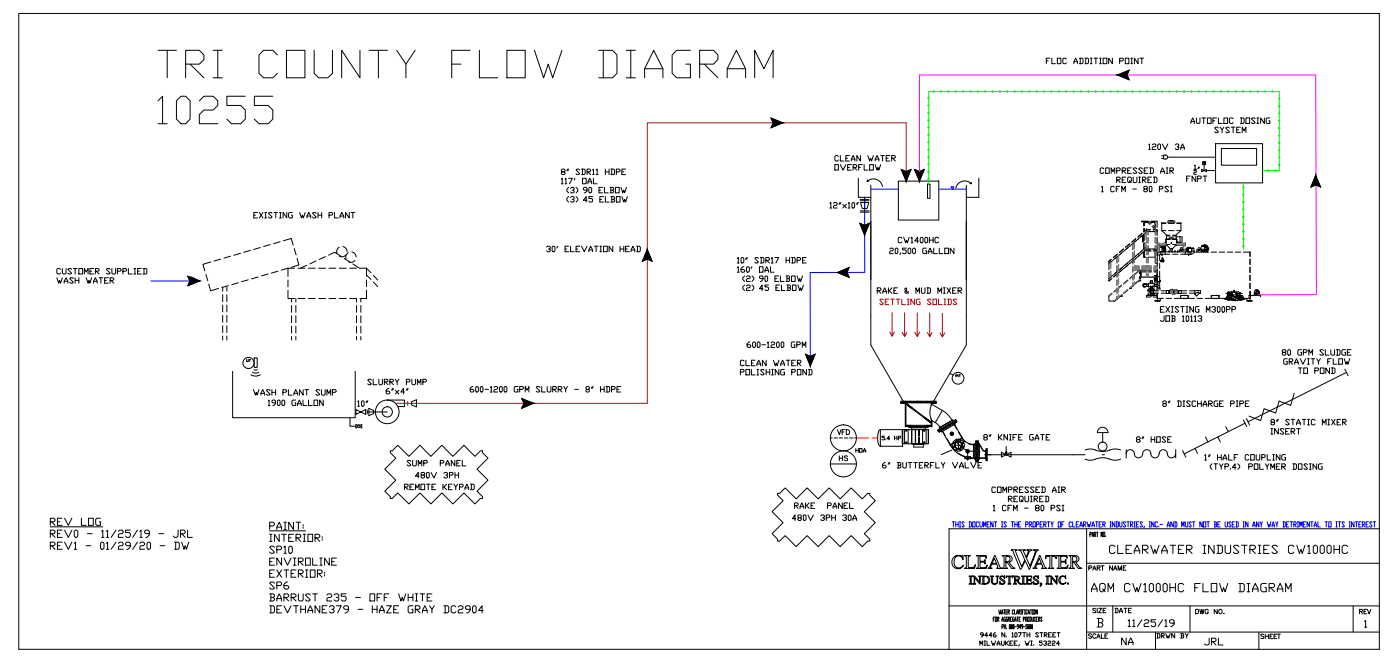
Client: Tri-County Paving, Inc.
Location: Arlington, Wisconsin, USA
Challenge: Eliminate settling pond, Increase uptime
Treatment: Flocculation & High Compaction Clarifying Thickener
Capacity: 1,100 GPM
Unit Type: M500PP, AutoFloc Dosing System, CW1400HC
Results: 64% w/w mud, 95% clean water for reuse
Challenge:
Tri-County Paving Inc. is a paving contractor that services the commercial, municipal and residential sectors in the Madison, Wisconsin region. To meet the demand of the growing metro area, Tri-county absorbs aggregate production to feed their 550 tph asphalt plant. From April to Thanksgiving, trucks are lined up waiting for product. Efficiency and uptime are critical to meeting the demand.
The aggregate wash plant consists of a triple deck, sand screw, and fines recovery system processing 300 tph of man sand or crushed limestone. To remove the solids from their wash water, they previously used a series of conventual settling ponds. Unfortunately, many solids were too fine and didn’t settle quickly enough, which caused production delays due to no clean water. Tri-County also spent days cleaning the ponds, increasing operating costs, reducing production, and putting wear and tear on equipment.
“The ponds were a headache,” said Plant Manager Rob Bierstaker. “We had to shut down production, spend 3-4 days cleaning the ponds and then 2-3 days filling them back with water so we had clean water ready for the wash plant.”
The settling ponds were a substantial economic expense that cut into Tri-County’s production time. They knew they needed a solution to remove fines from their wash water quickly and a smarter way to manage the waste mud.
Solution:
When Tri-County Paving first started looking for solutions they were focused on cleaning up their settling ponds.
In 2017, they came across Clearwater Industries, Inc. and sent Clearwater slurry samples of their process water for jar testing. Clearwater identified the top-performing polymer flocculant and installed an M500PP Dry Polymer Make-Down System.
Clearwater identified the top-performing polymer flocculant and installed an M500PP Dry Polymer Make-Down System.
“It used to take us 3-4 days to clean our mud pond,” said Rob in 2017. “We have it down now to where we can usually get it done in a day. The labor savings on that alone pay for the product.”
The M500PP provided immediate results for Tri-County’s settlings ponds which received about 1,100 GPM. The system dosed a polymer flocculant solution directly into their settling pond, which dropped the suspended solids out quickly. The settled solids compacted at the bottom of the pond creating a handleable mud while returning clean water to the production process.
“Prior to this, we use to take the mud to a secondary mud pit and leave there for a year to dewater,” Rob added. “Then we would bail it out of that pit with an excavator and put it onto a drying surface and then load it to haul away. It took that long to become firm.”
In 2020, Tri-County decided to remove their settling pond entirely by installing a CW1400HC Clarifying Thickener.

Clearwater worked with Tri-County to redesign their process water flow path to include: a slurry tank, CW1400HC, M500PP, AutoFloc Dosing System, two mud cells with sump.
The slurry tank and pump provide continuous dirty water to the top of the clarifier; automation accounts for any changes in flow rate. The M500PP polymer system was redirected to dose directly into the top of the clarifier at the effluent entrance. The AutoFloc Dosing System uses an infrared probe to monitor flocculation and adjust the polymer dosing pump accordingly, removing full-time operator attention and accounting for any changes in -200# fines or tph in the wash water. Finally, the two mud cells dewater the clarifier mud underflow until the dried mud is discarded.

“It takes about 8-9 days on average to fill one mud cell, so while one fills, the other one dewaters,” explains Rob. “And it usually takes about 5-8 days for the mud in a cell to dewater which allows us to clean it out while the other cell fills.
“Now it generally takes about nine loader hours to clean out a cell. Sometimes we have two going but usually just one loader. This has been a huge benefit because I usually have one guy running this plant, so he can grab a load of dewatered mud, drop it in the reclaim area, and then grab a load of feed material for the plant. We never have to shut down production now.”
Results:
The complete system provides a mud underflow of 64% solids by weight and returns 95% of clean water for reuse.
“It’s tough to quantify the cost savings on this but we know the system has been an absolute benefit to our bottom line,” said Rob. “We had cleaned out our settling ponds about 3 times per season with 5-7 days of downtime each time. Gaining those production days back was a clear return on investment.
“Even bigger than gaining the production days back is having loadable mud from the clarifier. It’s an absolute waste product for us that has to be hauled. Now, after 5-8 days of dewatering, we can load it into a dump truck and take it to its final destination.
“There are huge savings in not having to handle the mud multiple times,” Rob added. “Clearwater’s systems started paying for themselves immediately.”




